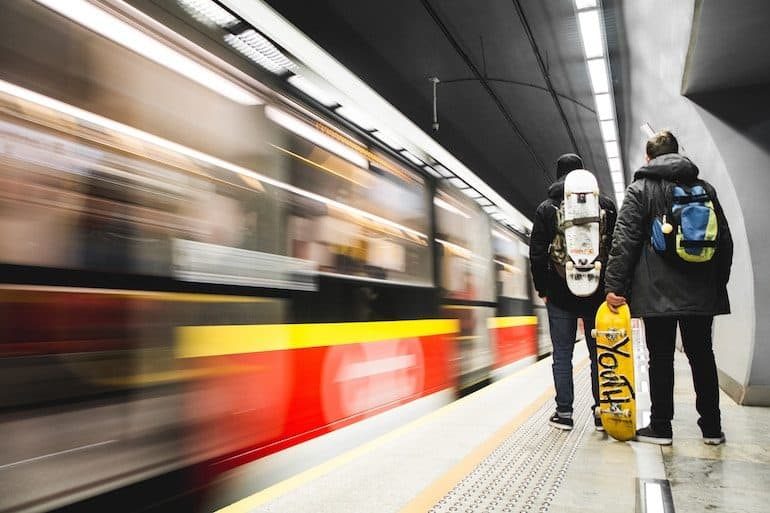How to use Rome’s public transport
Compared to learning Italian or suffering through bureaucratic procedures, navigating Rome’s public transport system can be one of the easier undertakings for foreigners. As you build a routine commute to university or work, it’s important to find transportation that works best for you and learn how to use it like a native resident. Here’s everything you need to know about Rome’s public transport travel pass options from the metro to the bus and tram.
Where can I buy public transport tickets in Rome?
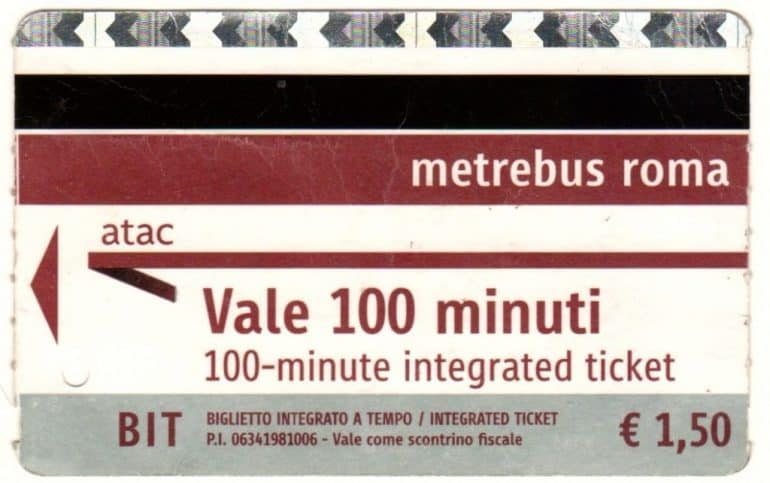
The metro, bus, and tram use the same tickets or biglietti, which you can buy at Tabacchi shops (sops with the black and white T sign), newspaper stands (edicola/giornalaio), and metro stations. Or, the app MyCicero is available for iPhones and Androids to easily purchase tickets public transport tickets in Rome (and all through Italy) whenever you want.
How much does public transport cost in Rome?
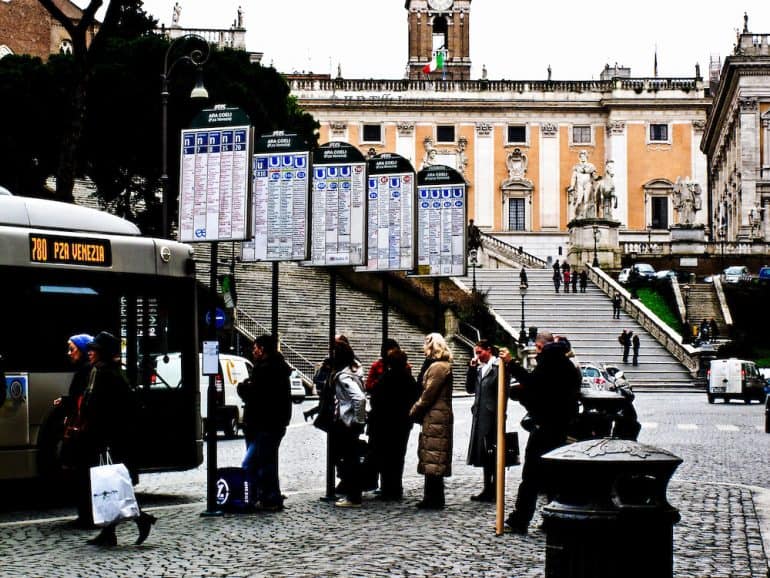
You can buy different public transport tickets depending on how often you use public transportation, ranging from 100-minute use (€1.50) to a one-year pass (€250). A single-use ticket for bus, metro, tram and trains inside the municipality of Rome costs €1.50 and is valid for 100 minutes from activation. The 100-minute ticket can be used for the metro for only one ride, but is valid for unlimited use for trams and buses. Children under 10 years old can ride public transit for free, but for adults there are other tickets for unlimited use for 24 hours (€7), 48 hours (€12.5), 72 hours (€18), and one month (€35 or €53 for a transferable, multi-person use ticket). Discounted tourist tickets for 72 hours (€16.5) and one week (€24) are also available.
How do I validate a public transport ticket in Rome?
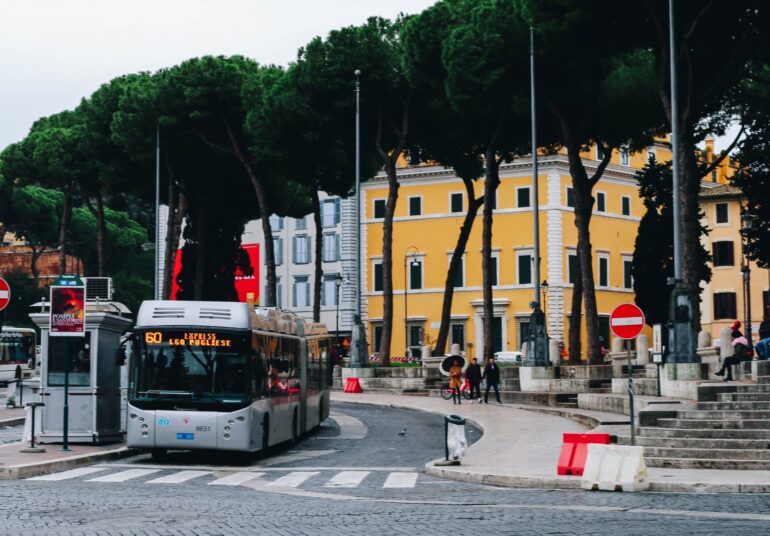
You must validate your public transport ticket when you enter the bus, metro or tram. The metro requires you to scan it to proceed to the platform. On buses and trams, you’ll find yellow boxes to validate your ticket. There is no system on buses and trams that enforces passengers to buy tickets, but there is the risk that ATAC officers (transportation authority of Rome) will check passengers for tickets and deliver a €50 fine to those who haven’t bought or validated their ticket. Some bus lines also allow you to purchase a ticket on the bus by paying an additional €0.50, for a total of €2.
How does the Metro work in Rome?
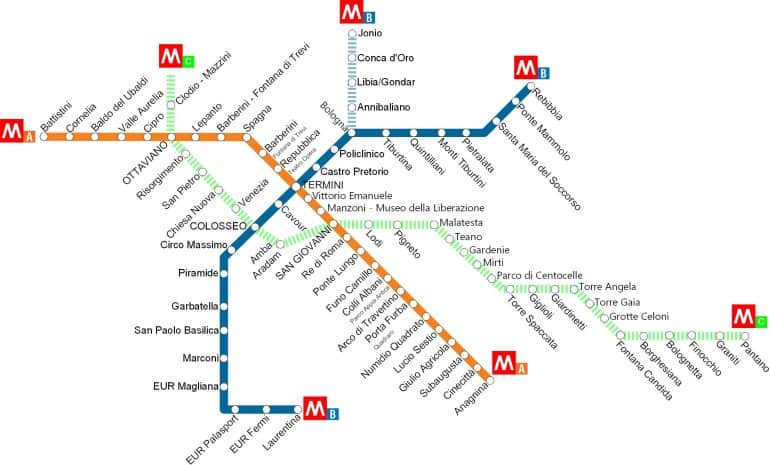
Have you waited forty minutes for the bus and it still hasn’t shown up? Just hop on the metro! The entrances are easy to spot with their large read “M” signs, and its 74 stations keep you well connected with Rome more reliably than the buses. It currently has three active lines, A and B, and a C line that is not fully active.
Line A (Battistini-Anagnina): You’ll have easy access to popular tourist destinations like Piazza Vittorio Emanuele II, Termini station, the Spanish Steps, Villa Borghese, and the Vatican.
Line B (Laurentina-Rebibbia & Joino): This line will quickly transport you to Porta San Paolo train station, a main station for traveling to Ostia Antica and some beaches, via the Piramide stop. The Colosseum, Circus Maximus, and Termini are also easily accessible.
Line C (Pantono-Lodi): Rome’s third metro line currently has twenty-two working stops, but is still under construction in the historic center between the Colosseum and Piazza Venezia. Its S. Giovanni station opened in May 2018 and also serves as a museum for the archeological artifacts discovered during its excavation. Intersections to the A and B metro lines are still underway, but changes in the aboveground transportation network around the S. Giovanni stop allow travelers to change from the C to A metro line via bus.
Each metro line has a map inside the stations that shows all the stops. Before heading to the platform, just look at the map for your metro line and make sure your desired stop is between your current location and the last metro stop. The last stops of the metro lines (Battistini, Anganina, Laurentina, Rebibbia, and Jonio) determine which direction and platform to follow.
Metro Hours in Rome:
Mon-Thurs & Sun from 5:30 a.m.–11:30 p.m.; Fri-Sat from 5:30 a.m.–1:30 a.m.
Trams in Rome
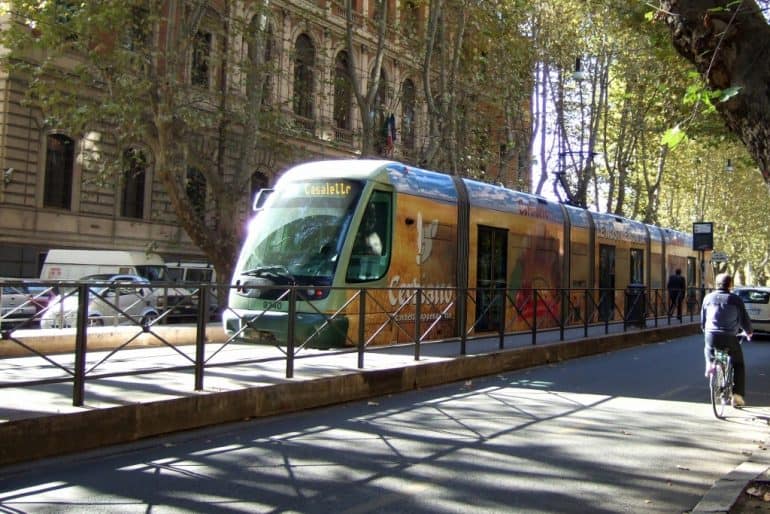
Trams are perfect for relaxing travel within the city and great views of popular ruins. Typically running every six minutes (or every twelve on Sundays), trams also offer a more consistent schedule than buses.
Six lines (the 2, 3, 5, 8, 14, and 19) connect Rome’s tourists and residents around several neighborhoods like Gianicolense, Trastevere, Monti, Flaminio, and Prati. The 8 tram is very convenient to students, running from Trastevere to Piazza Venezia with stops near Campo dei Fiori, Piazza Navona, and Largo Argentina. The 3 tram, stretching from Trastevere station to the National Etruscan Museum, provides a very scenic tour of the city with views of Piramide, Circo Massimo, the Colosseo, and the National Gallery of Modern Art.
Similarly to bus stop signs, tram signs note your location and the trams that run through that stop, or fermata. Each tram line has a list of stops between the first and last fermate on the line, which are clearly bolded. If your desired stop is not between your current location and the last stop, simply switch platforms and take the tram in the other direction. The trams stop at every place on the route, so there is no need to signal your fermata, unlike the city buses.
Tram Hours in Rome:
5.30 a.m. – 12 a.m. daily
Buses in Rome
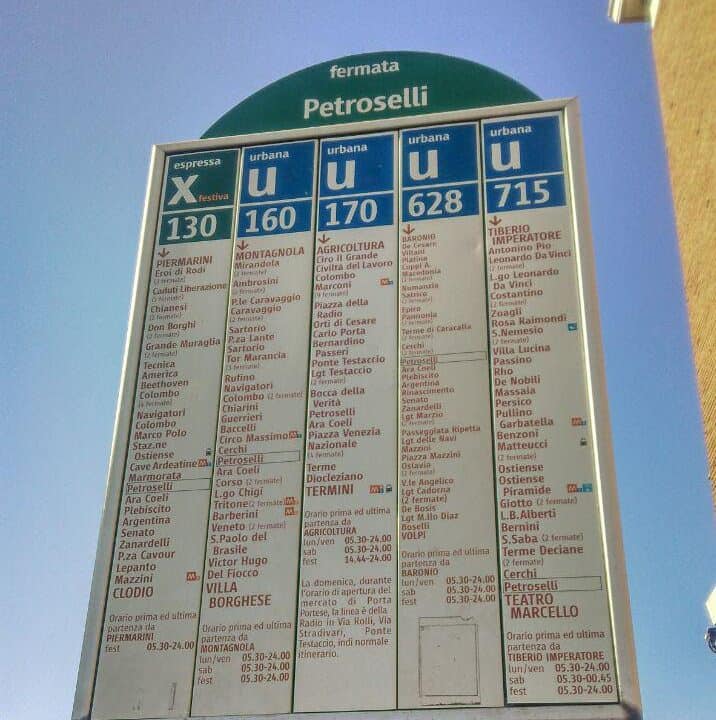
The buses seem to arrive on their own haphazard schedule (or never at all), so don’t forget your headphones and patience for your commute. The lax, erratic arrival times for the city buses imitate the lively rhythm of Roman life, and are a good lesson in accepting the unpredictable happenings in life! Citymapper, Autobus Roma, and Roma Bus (ATAC time bus Rome), are mobile applications and websites that can help smoothen your trip. In Citymapper (which functions in other cities), a list of buses, trams, and trains gives you multiple options for getting from your location to destination. The app also directs you to bus stops with a map, tells you when buses and trains will arrive, and notifies you when you’ve reached your stop if you’re unfamiliar with the area.
Bus stop signs note the location of the fermata, the various buses that run through it, and the list of stops on each bus route. You’ll notice some letters above each bus number–U, N, X, E–that indicate the different bus types. The majority of buses are urban lines (U), but there are also express buses (X) that travel to the outskirts of Rome and exact buses (E) for connecting the center with surrounding neighborhoods on fixed timetables. Night buses (N) replace the urban buses during the late hours. Other information, like changes in bus routes during holidays and festivals, are also noted on stop signs.
The first and last locations on the bus routes determine the direction you need to go in. If your destination is between your location (which is bolded or circled in the long list of stops) and the last stop, you are traveling in the correct direction. If it is above your location, you will need to change bus stops and wait for the bus traveling in the opposite direction. The two stops for each direction are usually across the street from each other or in close proximity.
When you see the bus arriving, approach the sidewalk and motion for the driver to stop. Unlike trams, buses do not stop at every fermata unless someone requests it. When you’re on the bus and ready to get off, press one of the red buttons you see scattered around the windows and doors. Don’t forget to validate your ticket once you’re on the bus. Here’s how to buy a bus ticket in Rome.
Bus Hours in Rome:
Urban lines – 5:30/6am to midnight
Night buses – midnight to 5 or 6 am
Is the Roma Pass worth it?
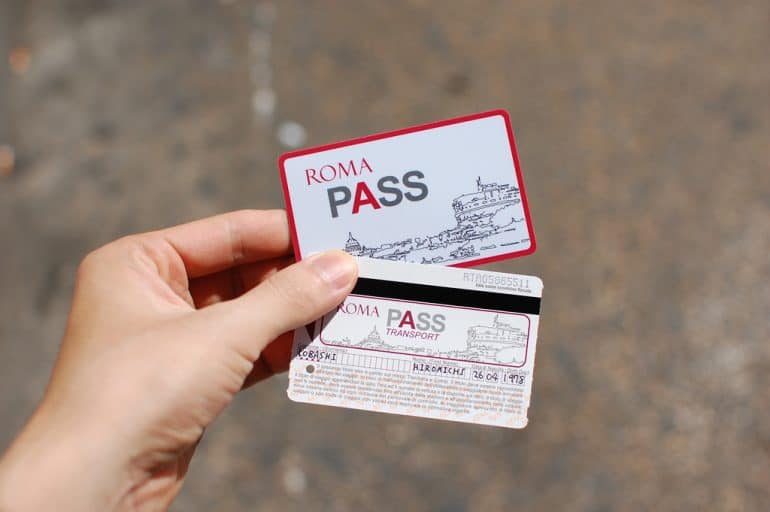
Touring Rome for a few days? If this is your first or second time in Rome and you’re planning on doing lots of sightseeing, the 48 or 72 hour Roma Pass could be worth it. This Pass allows you to visit cultural heritage sites and access public transit with just one card. Tourists can purchase their Roma Passes online before arriving to Italy and begin their exploration of the most exquisite monuments, museums, and archeological sites for discounted prices. Skipping long ticket lines, visiting a network of 50 galleries and museums, and using public transportation with ease makes Roma Pass a must-have resource for exploring Rome.
Taxis
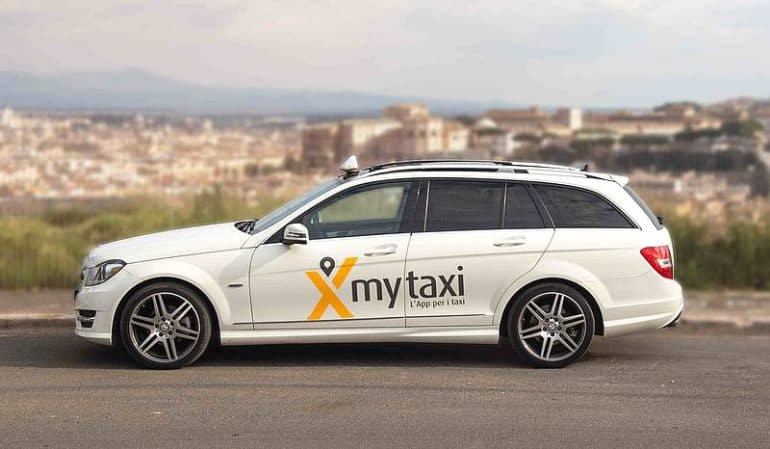
If you’re rushing to the airport early in the morning, calling a taxi may be less stressful for you. To contact a cab in Rome, you can call several different numbers: 06 3570, 06 4994, or 06 5551. If you call when you’re ready for a taxi, you can tell the operator your address, and the taxi will arrive shortly. You can also reserve a taxi for a specific time and pick up spot, and you’ll also have to provide your phone number.
You can also reserve a taxi online, with an app called FreeNow, which works similarly to Uber. MyTaxi allows you to see cabs around your area, estimate the cost of your ride, and track your taxi’s arrival. The app also allows you to reserve a cab ahead of time for early or late departures.
Car Rental

For those feeling adventurous and holding an international driver’s license, renting a car is a great way to see the outskirts of Rome. Noteworthy sights include Lake Bracciano, the Park of Monsters in Bomarzo, and Amalfi coast, but there are many more attractions accessible by car. Drivers must be at least 18 years old and licensed for at least one year. An international license may not be required for some rentals, however it’s highly recommended. Age requirements vary by car category, but drivers under the age of 25 will pay a young driver surcharge.
Rentals are available from major transportation hubs in Rome, such as Termini station, Fiumicino Airport and Ciampino Airport, Tiburtina station, and on Via Cipro (Vatican). If you are looking for a short-term car rental company that operates all over Italy, check out rentalcars.com.
If you’re looking to use a car for a grocery run or short 24 hour trip, Car2Go is a hassle-free option. Utilizing the car sharing network is quick and painless with a downloadable app that scans your license (international license necessary for foreigners), provides a map with available Car2Go vehicles, and sends a pin to start the car. Parking is free in public parking areas, and Car2Go will even gift a four euro credit to your account if you refuel the car. You can easily travel within Rome in the “home area,” but dropping the car off in periphery zones will result in a €1.90 fee. Depending on car size, prices range from €.24 – €.29/minute or €.29/kilometer after the first 200 kilometers traveled in long distance trips. Car2Go also offers flat rate rides to and from Fiumicino and Ciampino airports for €9,90 or €5,90.
You might also notice red Fiat 500’s buzzing around Rome. Enjoy is an alternative car sharing experience that uses a similar rental system for quick trips (at €.25/minute) or long hauls. Drivers must be at least 18 years old and licensed for one year, but differently from Car2Go, Enjoy accepts licenses issued from other European countries and the U.S. After registration, you’ll receive a unique pin to unlock any Enjoy vehicle you use, unlike Car2Go that sends you a new pin every time you rent a car. Enjoy also uses a map to find available vehicles that you can book for free, however a fee of €.10/minute kicks in if you don’t begin using the car after fifteen minutes. Enjoy cars are available in Rome, Milan, Florence, Turin, and Catania, and rental trips must end in the coverage zones of those cities. You can travel outside of the coverage zones for an unlimited amount of time (with an additional fee of €.25/km after the first 50 km traveled), but you cannot travel outside of Italy. After your trip, you can park in any public parking area inside the coverage zone for free, or you can use reserved Enjoy parking at Termini, Fiumicino, Ciampino, and other transportation hubs for €9.50 or less.
Check out Rome’s Airports Guide
Check out how to get to and from Fiumicino Airport
Check out how to get to and from Ciampino Airport
Check out the Essential Student Guide: Setting up your life in Rome


